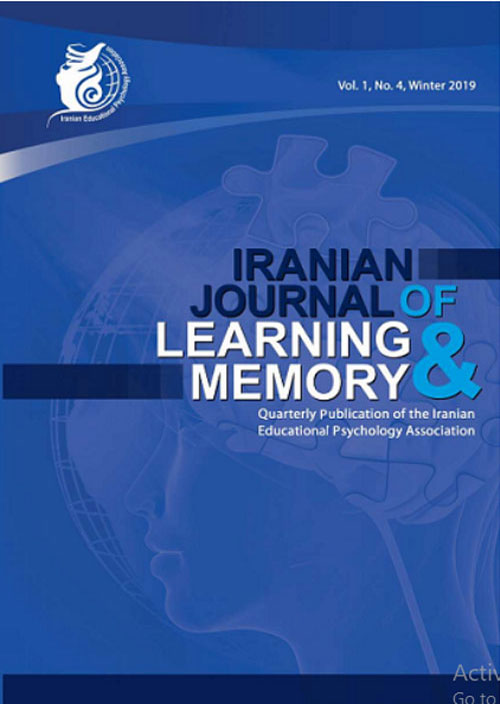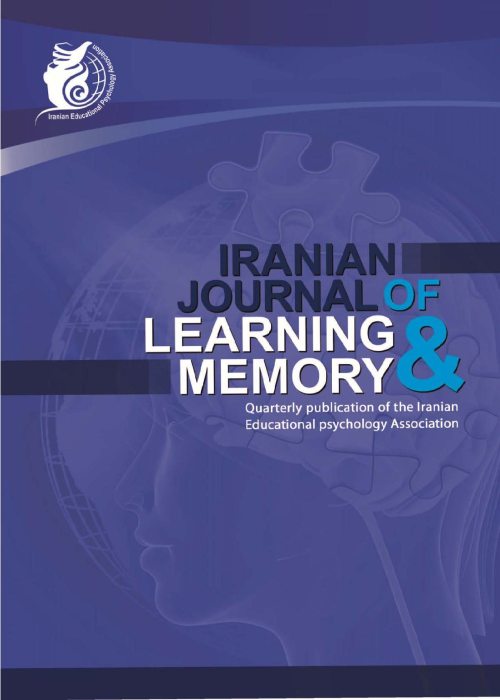فهرست مطالب

Iranian Journal of Learning and Memory
Volume:3 Issue: 9, Spring 2020
- تاریخ انتشار: 1399/03/08
- تعداد عناوین: 7
-
-
Pages 6-17
The present study aimed to design a curriculum pattern on the basis of critical thinking and its use among the undergraduate students of Isfahan University. This research is applied in terms of purpose using a mixed method in data collection. The research method in the qualitative part is content analysis and the tool used to collect data was note-taking. As the statistical population of this study, in the qualitative section, of all written sources gathered by targeted sampling method, only critical- thinking related sources were selected as the research samples. In the quantitative part, the research method was descriptive-survey and the tool was a researcher-made questionnaire whose content validity was examined by experts and its reliability using Cronbach's alpha was 0.94. The statistical population in this section included the faculty members of the University of Isfahan, and based on Morgan and Krejcie tables, 230 of them were selected by sampling method appropriate to the size of the statistical population. According to the results of this study in the qualitative part, the characteristics of the elements of the curriculum model based on critical thinking were extracted and in the quantitative part the results showed that the curriculum model on the basis of critical thinking is used by faculty members among undergraduate students.
Keywords: content, critical thinking, evaluation method, goal, teaching method -
Pages 19-27
The present paper sought to investigate gender differences in the speech pauses made by Iranian bilingual (L1: Turkish and L2: Persian) learners of English as a foreign language (EFL). To this end, the pauses made by males and females were compared. Via an Oxford Placement test, a convenient sample of 40 bilingual advanced EFL male and female learners were selected from several English language institutes in Tehran, Iran. Three reading passages (English, Persian, and Turkish) were used to measure students’ fluency in terms of their speech pauses in the texts they read. As learners started to read the passages, their speeches were recorded. The collected data were analyzed by means of Praat Software. The data were analyzed in terms of the frequency and duration of the recorded pauses. The results indicated that that there were not any statistically significant differences between males and females regarding their pause frequency and duration across languages. Accordingly, the results represented more similarity than difference across the groups. The implications of the study results are discussed.
Keywords: fluency, gender differences, Pause Duration, Pause Frequency -
Pages 29-39Recently, numerous studies have investigated the influence of technology use within the educational settings pointing that the perception of the students as well as the instructor towards technology use is indicative of how well technology might be integrated in instruction. Therefore, this study was designed to explore university lecturers’ perceptions toward instructional technology, their actual versus perceived ICT literacy, the extent to which they integrate technology in their instruction and the challenges they face in successfully integrating instructional technology in academic context. The study adopted a mixed method design and was of exploratory nature. The population consisted of 711 male and female university students studying in different majors including Science, Engineering, Humanities, and Art. Also, 111 instructors teaching different fields took part in the data collection process. Two different questionnaires were devised for the instructors and the students. Besides, for gathering more reliable data, a semi-structured interview was conducted with 51 instructors and 135 students together with an observation to give more depth to the data. The data were analyzed both qualitatively and quantitatively. The study concluded that university lecturers had positive attitude toward ICT and were moderately proficient in the use of ICT while university students had different levels of ICT knowledge and were mostly willing to experience digital learning. However, some limitations were mentioned in the study which shows an urgent need for some measures to be taken for continuous training of university lecturers in ICT which in turn leads to training more knowledgeable digital generation.Keywords: ICT literacy, Perception, University Students, University Instructors
-
Pages 41-51This research investigated the effect of using the reverse-learning approach on academic goal-oriented and lifelong learning of teacher students of Farhangian University. This is an applied research using a quasi-experimental research method. The research design was pre-test and post-test with the experimental and control groups. The population of this research included all teacher students of Farhangian University who were studying in the academic years 2018 and 2019. A cluster randomized two-stage random sampling method was used to collect the sample. At first, a pre-test of educational goal-orientation and lifelong learning was administered in both groups and after the implementation of the course at the end of the first semester, both groups were subjected to the post-test. To analyze the data, descriptive statistics including mean and standard deviation and inferential statistics, multivariate analysis of covariance analysis were used. Findings of the study showed the effectiveness of reverse education compared with the traditional method on academic goals and lifelong learning.Keywords: educational goals, inverse learning, Lifelong learning, University of Farhangian
-
Pages 53-64This study attempted to investigate the effects of cultural background knowledge on vocabulary learning through reading culturally oriented texts. The study was conducted with 150 upper-intermediate male (n = 75) and female (n = 75) EFL students. The participants of each gender were randomly assigned into three equal groups: group A (Target Culture = TC), group B (Source Culture = SC) and group C (Culture-Free = CF). After homogenizing the participants through a researcher-made vocabulary pretest, three groups received the treatment which was reading comprehension materials reflecting a particular culture. During the treatment, some reading passages related to American and English cultures, Persian culture, and culture free materials were taught to group A, group B, and group C, respectively. At the end of the study, a researcher-made vocabulary posttest was administered. Results of one-way ANCOVA and paired samples t test revealed the significant effects of cultural familiarity whereby vocabulary gains were greater after participants read within the culturally oriented text. Moreover, the results showed that there was no significant difference in vocabulary knowledge posttest between male and female learners.Keywords: Cultural Materials, reading comprehension, Source culture, Target Culture, vocabulary learning
-
Pages 65-73This study aimed to compare the effect of using conceptual map and traditional instruction on cognitive learning of Senior high school students in thinking and media literacy course. This is a quasi-experimental research using experimental and control groups. Three classes were chosen randomly (one for conceptual map teaching, one for the combination of lecture-based and conceptual map teaching (combined) and one as the control group). In the combined group, learners were taught though conceptual mapping while the experimental group was exposed to both teacher-made conceptual map and combined method in eight sessions and the control group experienced traditional instruction. All the three groups completed the teacher-made academic achievement test in both levels of knowledge and high level of thinking. The validity of the instrument measured through S. H. Lawshe formula was 0.78 and the reliability measured through Kuder - Richardson was 0.807. In order to analyze the data, covariance analysis was used. The findings of this study showed that the instruction was not effective at the level of knowledge, but there was a significant difference in the high level of comprehension which means that the highest effect was observed in the lecturing and conceptual mapping group (combined) while the lowest effect was attributed to the control group. Keywords: Presentation and construction of concept map, Bloom cognitive levels, Concept map, Meaningful learningKeywords: Bloom cognitive levels, concept map, meaningful learning, Presentation, construction of concept map
-
Pages 75-86
The present quantitative study examined the role of a set of socially-mediated personal attributes that might intervene in the speaking performance of Iranian EFL learners. The possible relationship between three factors (namely, Willingness to communicate (WTC) in L2, L2 communication confidence, and Beliefs about L2 group work in L2 speaking), which are hypothesized to influence learners’ oral performance, was investigated. In fact, a model reflecting the hypothesis that these three variables would influence the learners’ speaking performance was constructed and tested by collecting data from a convenient sample of 100 B.A. university students in Iran. In order to collect the required data on the above-mentioned variables, a comprehensive questionnaire developed by Fushino (2010) and IELTS speaking test module 1 were utilized. The structural equation modeling confirmed that these three variables were very good predictors of performance of Iranian EFL learners on speaking skill. In other words, the measurement model of this study was approved and the conceptual model of research had an acceptable level of fit index. In addition, the result of multiple regressions indicated that L2 communicative confidence made a higher level of contribution in explaining the L2 speaking performance of the learners, which corroborates the association of these two constructs. The findings of present study also implied that increasing EFL learners’ WTC, communication confidence and beliefs about L2 group work is likely to help to improve their speaking ability and learners who have higher levels of L2 WTC and confidence are likely to achieve higher scores on their speaking performance.
Keywords: Beliefs about L2 group work, L2 communication confidence, Personal attributes, Speaking Performance, Structural Equation Modeling (SEM), willingness to communicate


